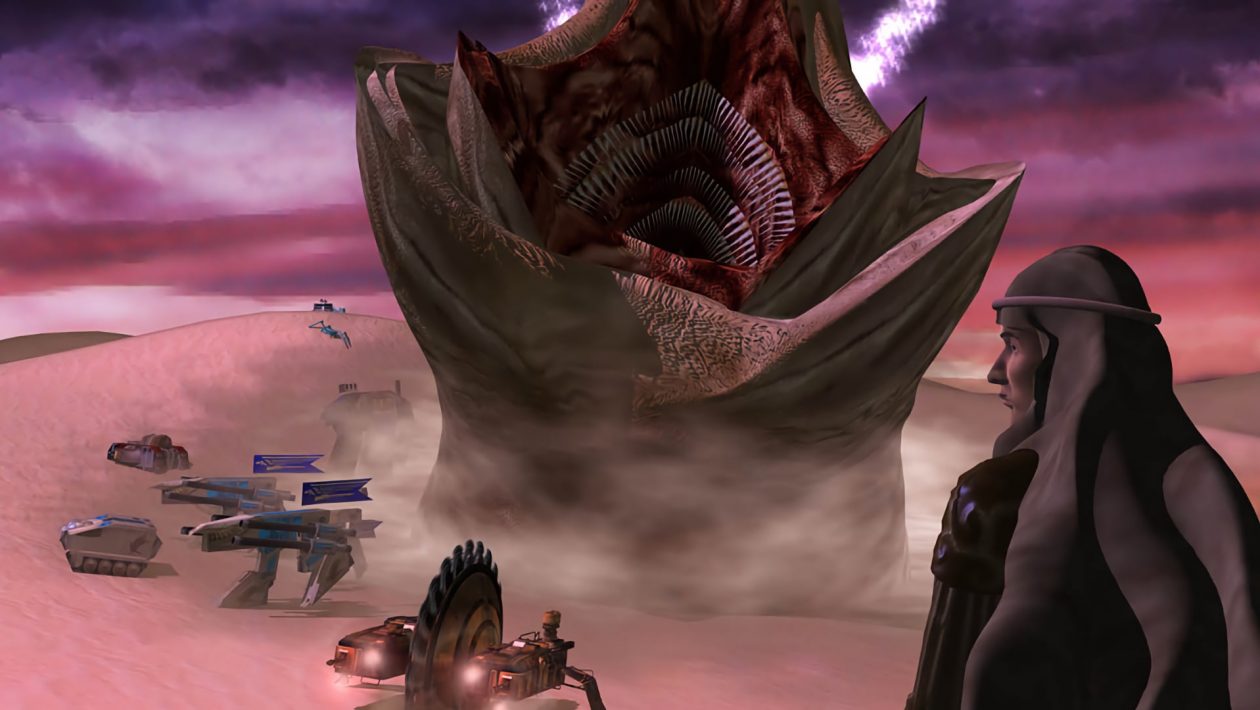History of Games According to Dune, Part Four -apkrig
Although Dune 2000’s real-time strategy has not made such a hole in the world as its Dune II model, it has accomplished something similarly important in its own way – it has paved the way for a full-fledged successor. Emperor: Battle for Dune was released in June 2001 and was a direct sequel to Dune 2000. The game again attracted to movie sequences, but unlike Dune 2000 for PC, it bet on full three-dimensional graphics, with which the previous game in the PlayStation version flirted.
Under the Emperor, the teams Intelligent Games and Westwood Studios are signed. The game again attracts us to the struggle of three well-known genera, but it comes with a number of innovations and innovations in the field of design and gameplay. The third real-time strategy from the Dune universe offered new units, a non-linear story campaign and great 3D graphics for its time. Although, true, it didn’t catch everyone’s eye either. It was in the field of strategy at that time that bread was still being broken when it came to 3D adoption.
The beginning of the game Emperor: Battle for Dune also directly follows the end of Dune 2000 from the point of view of the genus Ordos. It was the first time that a Westwood game had made the victory of the “bad” party a canon.
In addition to the three main genera, smaller factions also played an important role here, and we went to several different worlds. Suddenly, next to Arrakis, planets like Caladan or Giedi Prime did not sound like distant echoes. The tactics were also more varied in terms of attack and defense of their own territories, and similarly, the controlled units had different modes of operation.
Through the Emperor, we also learned that the homeworld of the genus Ordos is called Draconis IV. The beginning of the game Emperor: Battle for Dune also directly follows the end of Dune 2000 from the point of view of the genus Ordos. It was the first time that a Westwood game had made the victory of the “bad” party a canon. Normally the sequels and data discs of their titles viewed the conflicts as if the previous game had ended in victory for the “good ones”.
The game did not originally offer a map editor, but at the numerous requests of fans, the authors eventually made it available. Westwood has also released several custom map packages. I was also quite surprised by the information that the authors had already prepared a special bonus for pre-orderers at this time. The one who ordered the Emperor in advance received a code that unlocked three special multiplayer units, which is a potentially quite dangerous benefit. And indeed, as you can probably imagine, it already caused a great stir in its time and the media beat the authors really hard.
Players again complained about artificial intelligence, but in principle the game was quite enjoyed, although the verdicts ranged from absolute marks to very low. I could quote you from various reviews, but it is worth mentioning, for example, the one from the then very popular and respected Adrenaline Vault website, which is one of the critical ones. Its author notes that fans of the original and the film will appreciate the game, but otherwise he does not like it very much and awarded only 50%. “There’s no doubt that Emperor: Battle for Dune will set a new standard in real-time strategy graphics, but nothing more. It’s not a bad game, but Westwood’s RTS are starting to suffer the curse of Lara Croft – they’re getting older. There is nothing new except the beautiful form, “he adds, adding that the authors are trying, but even a change in the engine will not save the game from the feeling that we have actually played it.
All that remains is to shrug, what would the fans pay for such a “recycled” today. But not only the graphics but also the musical accompaniment deserved praise. Westwood court composer Frank Klepacki, who has already composed music for Duna II or the Command & Conquer series, did not take part in the soundtrack. Jarrid Mendelson and David Arkenstone also added to the notes. The purpose of this triple track was for each genus in the game to have its own unique sound.
The cast is again worth attention. Probably the most famous stars were Michael Dorn (Worf of Star Trek) as Duke of Achillus Atreides, Michael McShane as Baron Rakan Harkonnen and Vincent Schiavelli as Yanich Kobal. Several actors even returned and appeared in their roles from Dune 2000. For example, Adrian Sparks as Emperor Frederick IV. Corrino or Musetta Vander as Lady Elara.
But the film scenes are also interesting in terms of overall stylization, architecture, fashion and design. The set, the costumes and the scenery were significantly inspired by the film by director David Lynch from 1984. And when this parallel was directly offered, it is quite interesting that there are even more connections between the game, the film and Star Trek. Michael Dorn as Achillus Atreides is not the first Star Trek actor in this universe. Already in Dune from 1984, Patrick Stewart played, who served the Atreides as Gurney Halleck. He later became Captain Picard, and in Star Trek, other actors from the Emperor appeared in supporting roles – Musetta Vander, Vincent Schiavelli, Nicholas Worth, Jack Orend and Adrian Sparks.
If you feel that Duna did not live up to expectations in the Emperor’s conception, I must warn you that the real downturn is yet to come. In the next part, we will look at Frank Herbert’s Dune based on a miniseries that was also shot in the Czech Republic. In the 2001 game, Cryo returned to the brand, but it was not a comeback as she had imagined. We’ll look at it in the next part of our series.



